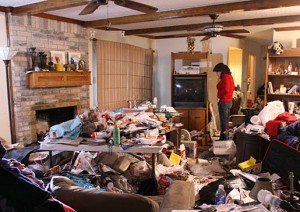Social Worker Constantina Boudouvas Answers Questions About Hoarding
National Association of Social Workers member Constantina Boudouvas appeared on an episode of the Discovery Channel’s “Hoarding: Buried Alive” that aired in early 2010.
There are a number of television programs that deal with hoarding, including “Confessions: Animal Hoarding” on Animal Planet and “Hoarders” on A&E. In fact, NASW member Mark Gaynor, MSW, ACSW, regularly appears on this season’s “Confessions: Animal Hoarding.”
“Hoarding: Buried Alive” producers contacted Boudouvas, MSW, through her work with the International Obsessive Compulsive Disorder (OCD) Foundation. They were looking for a therapist in Houston to work with Barbara Salzer, an oncology nurse who had filled her home with junk, trash and other debris.
Boudouvas had some reservations about being on the program because she was concerned it could be exploitative. However, she agreed to go on the air to counsel Barbara after she learned the show provides a stipend so people who are battling hoarding can continue to get treatment after the cameras are turned off.
SocialWorkersSpeak.org readers asked Boudouvas about hoarding and her appearance on the program. Here are her responses:
Q: What causes hoarding?
Boudovas: It’s complicated, like most things. For some people it can develop later in life as children leave home and people get depressed and are less motivated to throw things away. That is different from people who may have OCD and form an attachment to items so strongly that they find it difficult to throw them away. A lot of hoarders also have perfectionist thinking. They are afraid they may make a mistake and throw something away that they may need later, like a list or a magazine or some other information. For those who form an attachment to items they actually are truly distressed that they may be throwing away the ‘memory’ associated with that item, even if it is a piece of what most people might consider trash. Many hoarders have difficulty with organizational skills. They say they will save a newspaper and clip a recipe from it but they don’t and the newspapers pile up.

Barbara Salzer's home before social worker Constantina Boudouvas and others helped her address hoarding. Photo courtesy of the Discovery Channel.
Q: So people from any age group can become hoarders? It doesn’t just affect the elderly?
Boudouvas: It can happen at any age. I have a seven-year-old boy in my practice and he hoards. Hoarding can be a little bit more controlled in children because they can’t buy things. This boy won’t throw away boxes from the toys he gets because he feels it is important to mark the moment. And he collects trash because it commemorates events, such as getting candy for Halloween.
Q: Does medication help, therapy, or a combination of both?
Boudouvas: I think it’s a mix. Sometimes the anxiety of getting rid of these things is so intense for the hoarder that medication can help them gain some insight and make the anxiety more manageable. This may also allow for them to make some of the cognitive shifts they need to make with respect to how they are thinking of these “treasures.” Sometimes behavioral therapy is helpful. I have also found that using a professional organizer is also effective.
Q: What are the early signs of hoarding?
Boudouvas: A good sign of hoarding is when usable space is not able to be used for what it is intended. For example, there are piles of paper on the living room coffee table or people can’t use kitchen counter space because it has been filled up. Another sign is when guest rooms become filled up with stuff or, in the case of empty nesters, their children’s former bedrooms become cluttered. Interestingly, the hoarder usually doesn’t come forward to get help but someone they are in a relationship with. Often the family members come in to me to get help before the hoarders do. The family member will say, “I will leave you or I am willing to work with you on a plan.” That sometimes can motivate people to address their hoarding problem.
Q: Studies have shown there are high rates of comorbidity amongst hoarders, especially with ADHD and anxiety disorders such as OCD. Are these disorders warning signs hoarding could occur?
Boudouvas: Absolutely there is comorbidity. Someone may have obsessive compulsive disorder, which makes it difficult for them to relinquish an object as they will be anxious for a long period of time with the thought that they have gotten rid of something that was useful; or that they threw away a memory with the item. With the attentional difficulties it can make “sorting”‘ through things very difficult. That coupled with the fact that hoarding has been said to involve the “perfect compulsion.” If hoarders don’t ever throw anything away they don’t have to worry or deal with the thought or distress that they may have thrown something they may need, thus allowing them to indefinitely put off dealing with the anxiety unless family gets frustrated and fed up.
Q: Is there a follow-up with the family after the show airs?
Boudouvas: There is a follow-up. “Hoarding: Buried Alive” pays for 15 therapy sessions after the show ends. However, I made the commitment that if a person wanted to continue to get therapy from me after the show I would do so.
Q: Do you see social workers getting more involved in helping clients address a hoarding problem?
Boudouvas: I don’t know. As social workers we are trained to meet people where they are at. I sometimes do home visits or car visits with clients and feel comfortable doing so given my training. But I can’t say if it is a trend in the profession.
Social workers were some of the first professionals to recognize and study hoarding. Gail Steketee, dean of the Boston University School of Social Work, is one of the leading experts on the issue. Click here to read to read her article about hoarding on NASW’s “Help Starts Here” consumer Website. A good resource on hoarding for social workers and other mental health professionals as well as the public is “The Hoarding Handbook: A Guide for Human Service Professionals,” which was authored by Christiana Bratiotis, Gail Steketee and Cristina Sorrentino Schmalisch.
| Leave A CommentAdvertisement
1 Comment
Leave a Comment
You must be logged in to post a comment.




You note that Ms. Constantina Boudouvas was concerned about exploitation but that was resolved by the fact that a stipend was paid. I may be wrong, but that seems at best a simplistic and niave answer to the concerns of exploitation.
Maybe I’d be less concerned if there was information about how Ms. Boudouvas managed the many levels of social work concerns to maintain values and ethics like confidentiality and informed consent. What process did she undertake to resolve the inherent ethical concerns. It would also be helpful to hear how she engaged the client in an exploration of the issues of exploitation and how her treatment planning addressed the issue both while she was present and as the client’s story will be re-run for months and years. On that how did/does she address the implications to family members who may or may not have paerticiapted in the decision to approve filming but are directly and indirectly impacted.
If that information does not exist or those processes did not happen then I believe we have a problem. At that point we are settling with the argument that the ends justify the means, stipend justifies exploitation. For me, that doesn’t meet the smell test and seems unprofessional and unethical.